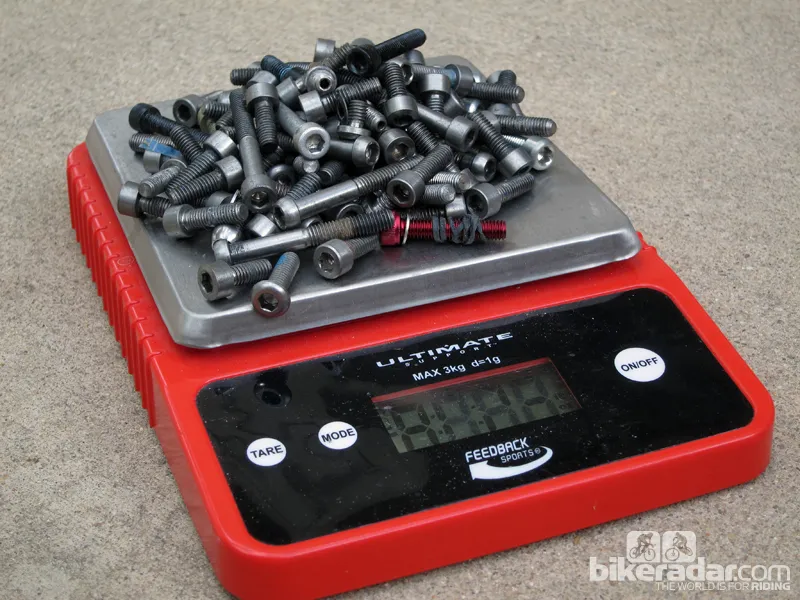A few grams here, a wisp of weight there – it can't possibly matter, right? Such marginal gains might be major targets for big pro teams but they aren't significant enough on their own for most riders to justify their associated costs. It's only when they're approached in bulk that they can add up to more meaningful sums.
There was a time back in my shop days when I obsessed over shaving every possible smidgeon of excess material. I scavenged titanium and aluminum bolts whenever possible, I weighed individual inner tubes and tires at our shop, and I made plenty of decisions that were in hindsight were rather ill advised, all in the name of the all-powerful scale.
I even bought cheap titanium bolts direct from a Chinese supplier once. It didn't go well.
These days I consider myself a (somewhat) reformed weight weenie but certain aspects of that mindset have never left me.
Few cycling circles epitomize the concept of marginal gains more than top-end professional teams with no improvement too small. To that crowd, seconds can sometimes hold major consequences and many teams have gone to extraordinary lengths to earn them. Think about the potential impact of a few seconds over the course of a three-week stage race or even tenths of a second in a World Cup downhill. Did that one little equipment change matter? At the end of a crucially important event, it's a certainly a question you don't want to think about.

Marginal weight savings are fun, but in terms of performance they don't really benefit everyday riders
Likewise, true weight weenies are often looked upon with equal measures of perplexity and bewilderment in a world where it's entirely normal to pay much, much more to get just a little bit less. Unlike the pros whose livelihoods depend on race results, these folks are competing only for pride and bragging rights, but a KOM in internet forum-land can sometimes feel just as valuable.
It all can seem rather insane if you're an average rider.
Taken on an individual basis, such miniscule things mean very little to most of us. Regardless of what the math tells us, the hard truth is that those small changes in weight aren't going to make a lick of difference to the vast majority of enthusiasts, especially those that don't live in especially mountainous areas or riders that are mostly concerned with how they feel on their ride, not shaving seconds from their favorite Strava KOM segment.
But take a step back and consider that sort of obsessive approach everywhere on a bike. Fifty grams saved on a single component? Big deal. But how about dropping a kilo by saving 50g on every component? Now we're getting somewhere.
The problem is that a piecemeal approach might eventually give you what you want but it's a strategy only big teams – or amateurs with big budgets – can afford. Sure, you're spending in smaller amounts so it hurts less but just like paying the minimum due on your credit card, the final tally is going to be much higher.
One could easily read into a little further and suggest that I'm telling people not to throw their hard-earned money away on singular, weight-driven upgrades unless it's for the sake of personal satisfaction or hobby – and you'd be partially correct, which probably sounds weird coming from a die-hard gear guy who writes about the latest and greatest bike widgets for a living and just admitted that he has a drawer full of (now unused) titanium bolts at home.
It would instead be more accurate to say, however, that I'm suggesting that you look more at the big picture when it comes to your gear. Incremental upgrades can still be sensible if they're viewed over time as part of a greater plan to improve a significant portion of your steed. Put another way, spending US$300 to save 50g doesn't make much sense. Spending US$3,000 to save a kilogram, on the other hand – either through a wholesale upgrade or an entire new bike – might be even more financially irresponsible, but at least that's a difference most folks will actually notice.
Alternatively, consider other performance metrics when pondering upgrades. What is it that you think about equipment-wise when you're on a ride? Are you constantly bemoaning how heavy your bike is or are you more concerned about things like durability, comfort, basic functionality (such as shifting, braking or suspension performance), or even aesthetics?
Whatever the answer, concentrate on that instead of how much something weighs. Sure, mass absolutely matters but if a small drop in weight also brings with it higher quality construction, a more refined ride, or something that just works better and lasts longer, that's a no-brainer. Do your research, though – lighter doesn't automatically mean better and not everyone has the same equipment requirements.
Then again, there's the whole argument that that money should instead be spent on soliciting a coach, high-quality food to fuel a proper training regimen, etc. – but that's not really any fun, now is it?
James Huang has been writing about bicycle tech since 2005 but also has more than 14 years of experience as a shop mechanic. In that time he's seen plenty of fantastic gear and technology but also a lot of things that just flat-out piss him off. Follow him on Twitter at @angryasian.